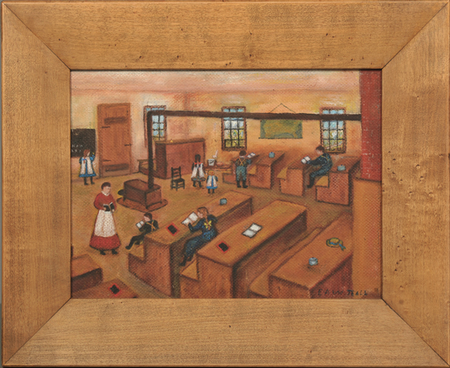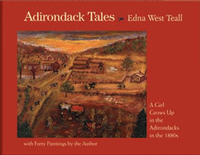Edna West Teall
”In the 1880’s, when I sat at the same desk as my mother before me, the hickory stick was not in evidence. The children of that period came from homes where they had been taught a certain respect for teachers and study. They were sent to school ’to be learned’ as some expressed it, and, except for minor mischief, were fairly studious.
Just inside the door, which was in the middle of the room, there was the big box stove perched on a layer of red bricks... the stovepipe went across the room to the chimney and became very hot, so hot that pupils complained about sitting the seats underneath, saying it gave them a headache. Those seats were not popular, anyway for you couldn’t see out the windows and know who was passing by.
At the end of each day, the pupils straggled out and the teacher shut the heavy plank door and locked it with a padlock and chain. Its staunchness served long and well, and it’s a pity it couldn’t have been saved for posterity. But maybe some of its sturdiness has gone on in the personalities of those who daily swung that heavy old door.”
-Edna West Teall, ”Adirondack Tales” (1970). The Adirondack Museum
Edna West Teall was born in 1881 in Essex, NY (Adirondack Museum). She grew up in Lewis, NY, before beginning a career as a journalist in New Jersey (where she lived for 30 years). After she retired from this career, she returned to the place where she grew up: the Adirondacks. While in the Adirondacks, she spent the majority of her time writing and painting about her childhood experiences in the Adirondacks in the 1880's. She created more than 40 paintings of her daily life and wrote extensively about growing up in the Adirondacks.
This is one of Edna West Teall's oil on canvas paintings. The subject matter is Teall's memory of the one-room country schoolhouse she once attended. This painting depicts wooden benches and tables, with school children sitting and standing, working on assignments as a teacher reads to them. There is a square stove in the center of the room with a thick dark pipe coming from the center and connecting to the wall behind the children.
This depicts the artist's own experience growing up in the Adirondacks. It is not done in a traditional or formal painting style, but the subject is clear.
Growing up in Adirondacks in the 1880s was a very defining experience for Teall. In 1970, Adirondack Life magazine published her book, Adirondack Tales: A Girl Grows Up in the Adirondacks in the 1880s, where she reflects on her childhood in the park. A review of Adirondack Tales sums it up nicely. This memoir offers specific insights into the "world of a hardworking farming community" (Zaleski). Teall wrote of "many joyful community events, like the annual fair and church gatherings" and she is "clearly nostalgic" as she remembered an outdoor life in which she thrived (Zaleski). Her memories are not falsely cheering though, as she also relates to some of the "narrower aspects of that society." For instance, her neighbors looked down on some immigrant groups. Rural families, like those of the author's, were in turn, regarded as hicks by the townspeople (Zaleski). Edna West Teall is a great example of a folk artist because her art and her writing revolves around her personal and everyday experiences growing up in the Adirondacks.


